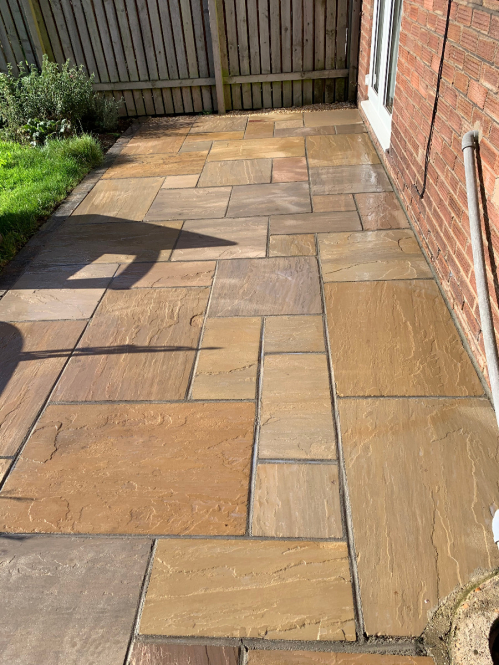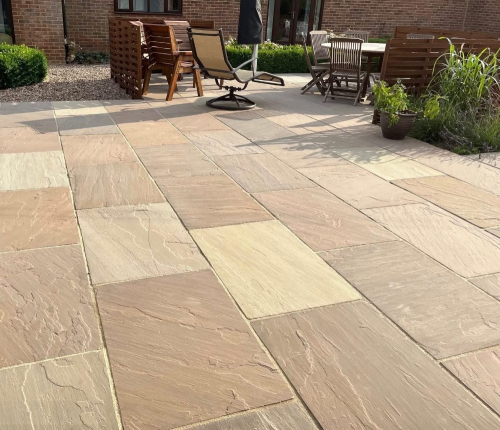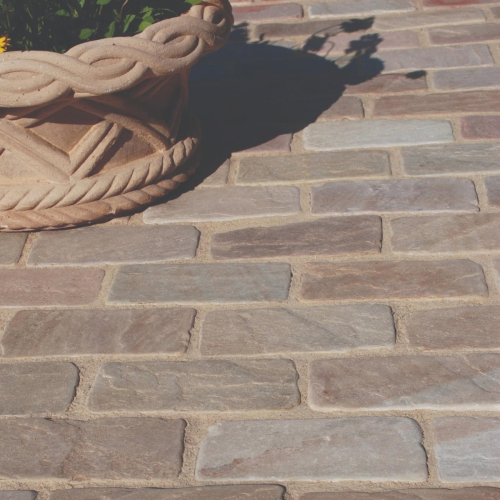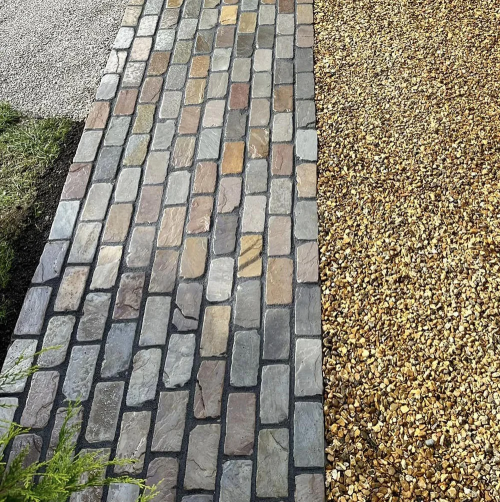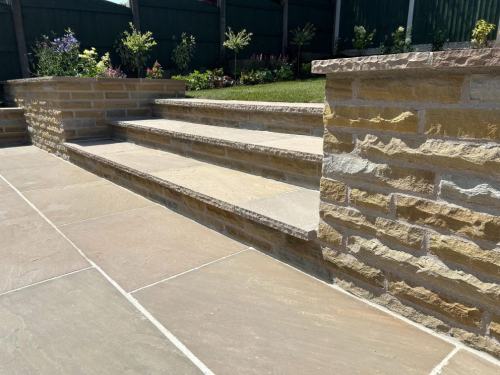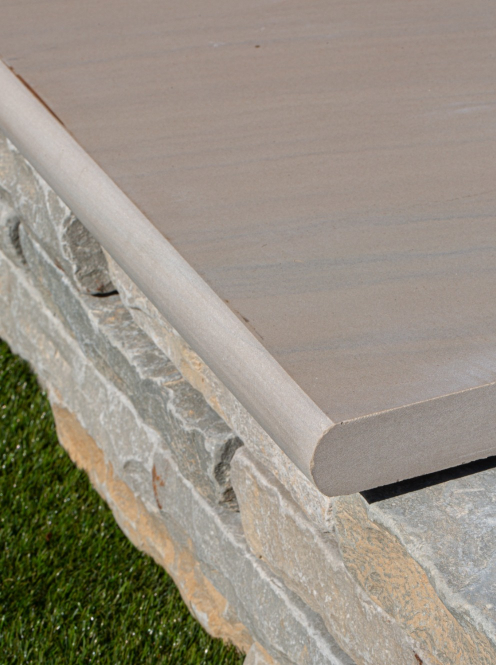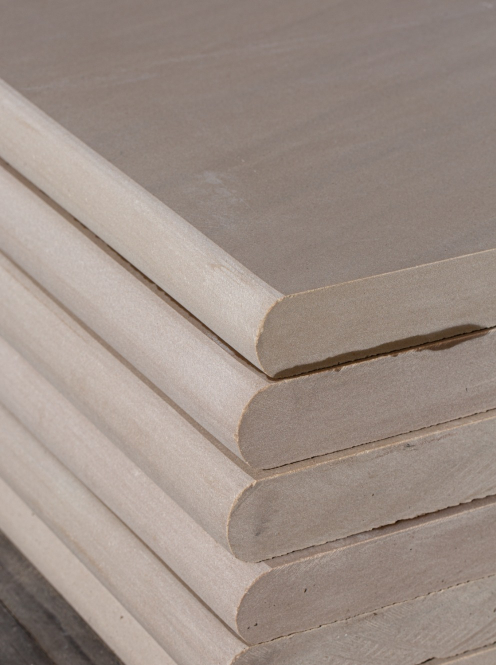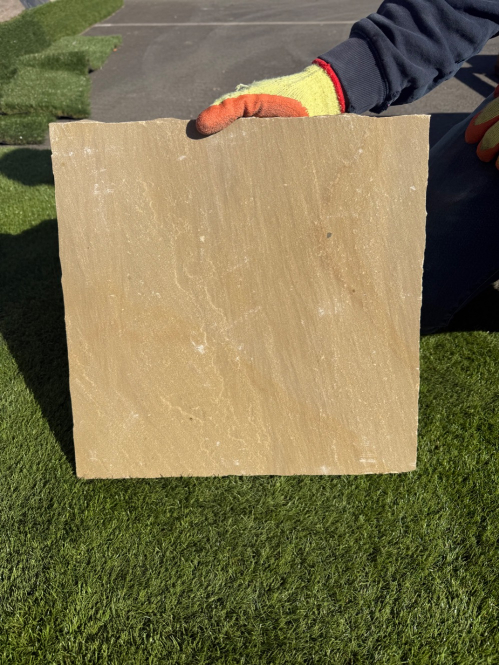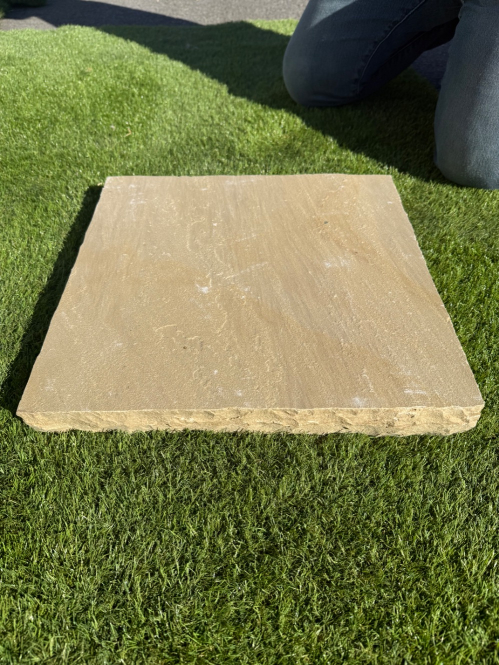Raj Green Sandstone
Raj Green is a natural sandstone paving that is ideal for homeowner looking to create a timeless classic garden design. Raj Green consists of browns, greys and greens that appear very similar to the traditional York Stone appearance but at a fraction of the cost!
At Melton Stone we stock a huge selection of Raj Green paving options from mixed size patio packs, stone wall copings, paving slabs, circle kits and sandstone cobbles.
If you a looking for a timeless classic paving in your garden then Raj Green is the choice for you.
- Dense, heavy duty, durable natural stone paving.
- Excellent slip rating
- Extremely Hard Wearing
- Low Maintenance
If you would to find out more about our beautiful paving selection please contact one of our paving experts today.
Speak to a member of our friendly sales team today on 01482 688008 or Email sales@meltonstone.co.uk
Raj Green Sandstone Paving
What colour is Raj Green?
Raj Green is a type of Indian sandstone known for its attractive blend of colours, which typically includes various shades of green, brown, and grey. The name "Raj Green" comes from the region of Rajasthan in India, where the stone is quarried. The exact colour variations can vary slightly depending on the specific quarry and the batch of stone, but the general colour range is as follows:
1. Green: The predominant colour in Raj Green sandstone is green, which can vary from light to dark shades. It may include olive green, sage green, and sometimes hints of mossy green.
2. Brown: Raj Green often features varying shades of brown, including tan, light brown, and deeper, earthy brown tones.
3. Grey: In addition to greens and browns, Raj Green can also have subtle grey undertones, adding to its unique and natural appearance.
The combination of these colours gives Raj Green sandstone its distinctive and rustic charm, making it a popular choice for a variety of outdoor paving projects, including garden patios, pathways, and driveways.
As with any natural stone, the colour of Raj Green can vary slightly from one piece to another, contributing to the stone's natural and organic character. When selecting Raj Green for your project, it's a good idea to view samples or images to ensure the specific colour variation aligns with your design preferences and complements the overall aesthetics of your space.
How thick are sandstone cobbles?
The thickness of Indian sandstone cobble setts can vary depending on the specific product and the manufacturer. However, typical Indian sandstone cobble setts are commonly available in thicknesses ranging from approximately 30mm (1.2 inches) to 50mm (2 inches).
The most common thicknesses for Indian sandstone cobble setts are 40mm (1.6 inches) and 50mm (2 inches). These thicknesses are suitable for most outdoor applications, including driveways, patios, pathways, and other landscaping projects.
When choosing the thickness of Indian sandstone cobble setts, consider the intended use and the level of foot or vehicular traffic the area will experience. For heavily trafficked areas like driveways, a thicker cobble sett is generally preferred to withstand the weight and pressure.
Is Raj Green a good choice for my cottage style garden patio?
Raj Green can be an excellent choice for a cottage-style garden patio, depending on the overall design and aesthetic you want to achieve. Raj Green is a type of Indian sandstone known for its beautiful blend of green, brown, and grey colours, which can create a natural and rustic look that complements various garden styles, including cottage gardens.
Here are some reasons why Raj Green might be a good choice for your cottage-style garden patio:
1. Natural Beauty: Raj Green sandstone has a charming and rustic appearance that aligns well with the relaxed and organic feel often found in cottage gardens. Its unique blend of colours adds character and warmth to the patio, creating an inviting outdoor space.
2. Versatility: Raj Green's versatile colour palette can easily blend with various garden elements, such as lush greenery, floral borders, and vintage-inspired decor commonly found in cottage gardens.
3. Texture: Sandstone's natural texture provides a soft, tactile feel that complements the informal and cozy atmosphere of a cottage-style garden.
4. Timeless Appeal: The natural and timeless look of Raj Green can add a classic touch to your garden, making it a patio that you can enjoy for many years.
5. Cost-Effective: Indian sandstone, including Raj Green, is often more budget-friendly compared to other natural stone options, making it an attractive choice for those seeking both beauty and value.
6. Easy to Maintain: Raj Green paving is relatively easy to maintain, especially if properly sealed, and it can withstand the outdoor elements well.
When planning your cottage-style garden patio, consider other elements such as garden furniture, planters, and lighting that will complement the Raj Green paving and enhance the overall ambiance. Also, think about the layout and arrangement of the patio to ensure it blends seamlessly with the rest of your cottage garden.
To make an informed decision, it's a good idea to view samples or images of Raj Green paving in cottage garden settings. Additionally, consult with a landscape designer or professional to discuss your specific vision for the patio and receive personalized advice based on your garden's unique characteristics and your preferences.
Should I seal Raj Green paving?
Sealing Raj Green paving is a personal decision and depends on several factors. Raj Green is a type of Indian sandstone known for its attractive blend of colours, including greens, browns, and greys. Whether to seal the paving or not is influenced by the following considerations:
1. Enhanced Colour: Sealing Raj Green paving can intensify and enhance the natural colours of the stone, making it more vibrant and visually appealing.
2. Protection from Stains: Sealing creates a protective barrier that can help repel liquids and prevent stains from oil, grease, and other substances that may come into contact with the paving.
3. Easier Cleaning: Sealed surfaces are generally easier to clean since spills and dirt are less likely to penetrate the stone. Regular maintenance can be more straightforward with a sealed surface.
4. Weather Protection: Sealing can provide some protection against weathering and UV damage, helping the paving to maintain its appearance for a longer period.
On the other hand:
1. Natural Look: Some people prefer the natural, rustic appearance of unsealed Raj Green paving, as the sealing process may slightly alter the texture and finish of the stone.
2. Slip Resistance: Depending on the type of sealer used, there is a possibility that the surface could become slightly more slippery when wet. Choose a sealer with anti-slip properties if slip resistance is a concern.
3. Maintenance: Sealed surfaces may require periodic resealing to maintain their protective properties. The frequency of resealing can vary based on the type of sealer used and the level of foot traffic and weather exposure.
If you decide to seal your Raj Green paving, follow these tips:
- Choose a high-quality penetrating or breathable sealer specifically designed for natural stone.
- Clean the paving thoroughly before applying the sealer to ensure proper adhesion.
- Test the sealer on a small, inconspicuous area to ensure you like the result before applying it to the entire surface.
- Follow the manufacturer's instructions for application and reapplication of the sealer.
If you're unsure whether to seal your Raj Green paving, consider seeking advice from a professional landscaper or stone supplier who can provide personalized recommendations based on your specific paving and its location.
Can I use sandstone slabs for a driveway?
Using sandstone slabs for a driveway is possible, but it's important to consider some factors before deciding:
1. Durability: Sandstone is a natural stone and can vary in hardness and durability depending on the specific type of sandstone. Some varieties of sandstone may not be as durable as other stone types commonly used for driveways, such as granite or concrete pavers. Sandstone is more susceptible to wear and can be prone to chipping and cracking under heavy vehicular traffic.
2. Thickness: For a driveway application, sandstone slabs need to be thick enough to withstand the weight of vehicles without breaking. Standard sandstone slabs for paving might not be thick enough for this purpose. Thicker and more durable sandstone pavers designed specifically for driveways might be available.
3. Surface Texture: The surface texture of sandstone slabs can affect traction for vehicles. Some sandstone varieties might have a smooth or polished surface, which could become slippery when wet. Look for sandstone with a textured or non-slip surface for better traction.
4. Maintenance: Sandstone is a porous material and can absorb stains and liquids. A driveway is subject to oil spills, tire marks, and other potential staining substances. Regular cleaning and sealing may be necessary to maintain the appearance of the sandstone.
5. Climate: Consider your local climate and how it might affect the sandstone. Freezing and thawing cycles, as well as extreme heat, can impact the integrity of sandstone over time.
6. Installation: Proper installation is crucial for a driveway. The sandstone slabs need to be laid on a stable and well-prepared base to prevent cracking and sinking.
7. Cost: Sandstone slabs suitable for driveways may be more expensive than other driveway materials, such as concrete pavers or asphalt.
Given the potential challenges, it's essential to consult with a professional landscape designer or contractor to assess the feasibility of using sandstone slabs for your driveway. They can help you determine the most suitable material and ensure that the installation meets safety, durability, and aesthetic requirements. If sandstone is not the best option for your driveway, there are other materials available that are specifically designed for heavy vehicular traffic and can provide a durable and long-lasting driveway surface.


